Wisconsin offers a rich habitat for many species of dragonflies, making it an ideal place to observe these fascinating insects in their natural environment. Dragonflies in Wisconsin can be seen near ponds, lakes, and wetlands throughout the warmer months, showcasing a variety of colors and behaviors that attract both casual observers and serious naturalists alike.
The diversity of dragonflies in Wisconsin reflects the state’s healthy aquatic ecosystems, as these insects depend on clean water for breeding and development. Studying dragonflies in Wisconsin not only provides insight into their unique life cycles but also helps monitor the overall health of local environments, since dragonflies are sensitive to pollution and habitat changes.
In this article, you will find detailed information and photographs of 16 common types of dragonflies in Wisconsin. Each species is described to help you identify them in the field, from the widely recognized common green darner to other striking species less often seen. This guide aims to enhance your experience exploring the remarkable world of dragonflies in Wisconsin.
Common Dragonflies Found in Wisconsin
Common Green Darner (Anax junius)

The Common Green Darner is a large and powerful dragonfly that stands out due to its vibrant coloration and impressive size. Males typically display a bright emerald-green thorax and a long, bluish abdomen with a characteristic black stripe running down the middle. Females may show similar coloring or a more subdued brownish tone, especially when immature. Measuring around 2.8 to 3.1 inches (7 to 8 cm) in body length with a wingspan of up to 4.7 inches (12 cm), this species ranks among the largest dragonflies found in North America.
One of the most notable features for identifying the Common Green Darner is the prominent bullseye-shaped mark on its face between the eyes, along with its completely transparent wings. These dragonflies are strong, tireless fliers, often seen cruising above ponds, lakes, and fields in a steady, purposeful flight. They are also famous for their long-distance migrations—comparable to those of Monarch butterflies—traveling hundreds of miles between breeding and overwintering sites in North and Central America.
In Wisconsin, Common Green Darners are among the first dragonflies to appear in the spring, sometimes even before the ice has fully melted from shallow waters. They are widely distributed across the state, favoring a variety of freshwater habitats including ponds, marshes, rivers, and lakeshores. Their presence throughout the warmer months makes them a valuable predator of mosquitoes and other flying insects, contributing to natural pest control in both urban and rural areas.
Twelve-spotted Skimmer (Libellula pulchella)
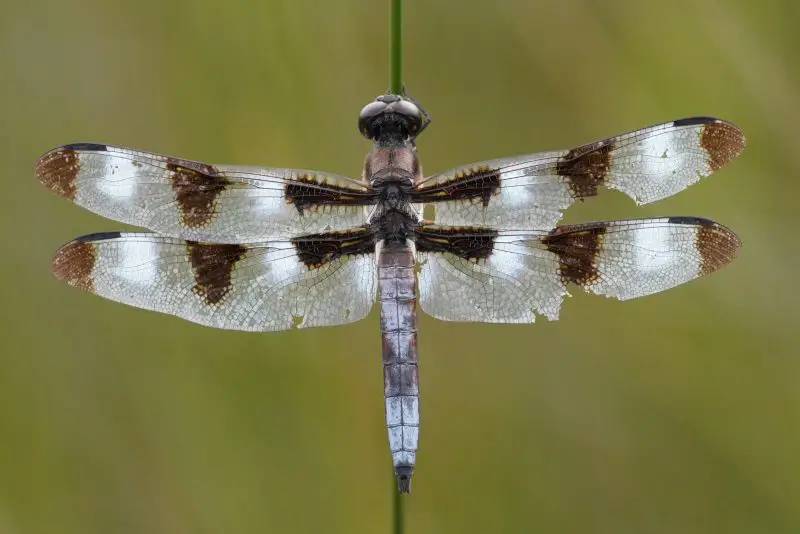
The Twelve-spotted Skimmer is one of the most visually distinctive dragonflies in North America, particularly noted for the striking black and white pattern on its wings. Each wing bears three dark brown spots, and mature males develop additional white patches between the black spots, creating a dramatic appearance that seems almost ornamental. Males also possess a broad, bluish-white abdomen, while females maintain a more golden-brown body with subtle wing markings.
With a body length of about 1.8 to 2 inches (4.5 to 5 cm) and a wingspan near 3 inches (7.5 cm), this medium-sized skimmer is both agile and confident in flight. Males frequently patrol open stretches of water, often returning to the same perch between flights. Their behavior is typically territorial, with aerial chases and displays to defend prime breeding areas from rival males. When not in flight, they are often seen basking in the sun on emergent vegetation or dock edges.
In Wisconsin, Twelve-spotted Skimmers are common throughout the summer, most active from mid-June to August. They are usually found near calm freshwater habitats such as ponds, slow-moving streams, lake edges, and wetlands. Their combination of eye-catching coloration and bold behavior makes them a favorite among nature watchers, photographers, and dragonfly enthusiasts alike.
Common Whitetail (Plathemis lydia)
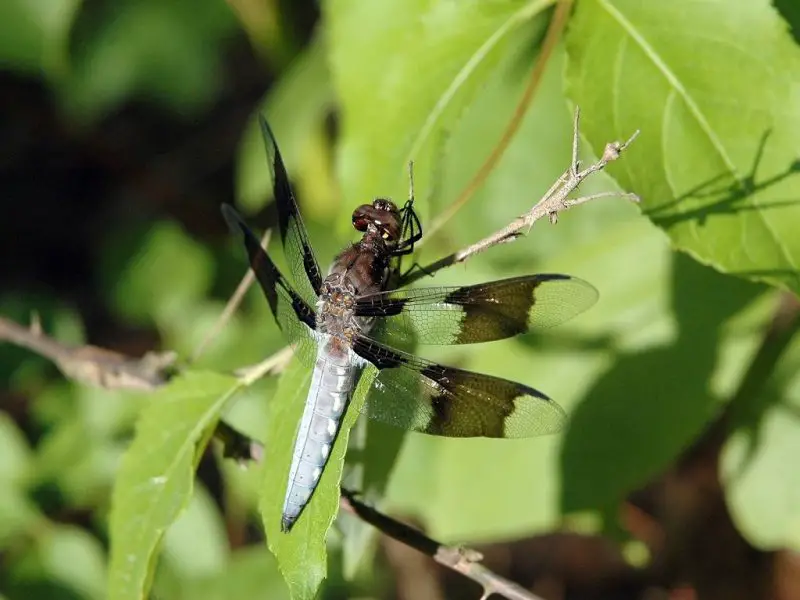
The Common Whitetail is a robust and easily recognized dragonfly thanks to its short, thick body and unique wing patterns. Adult males feature a chalky white abdomen with black wing bands that are especially bold near the base and tip of each wing. Females are more cryptically colored with a brown body marked by yellow side stripes and three evenly spaced dark spots on each wing, which distinguishes them from other dragonflies of similar size.
This species is on the smaller end of medium-sized dragonflies, with an average length of about 1.7 inches (4.3 cm) and a wingspan of 2.5 to 3 inches (6.5 to 7.5 cm). Common Whitetails often perch low on the ground, on rocks, logs, or bare soil, rather than high up on reeds or shrubs. Their flight is typically fast and direct, but they often pause to rest, allowing observers a good look at their features. Males will patrol a small stretch of shoreline aggressively, chasing away rivals and attempting to attract females.
In Wisconsin, the Common Whitetail is one of the most frequently encountered dragonfly species, often seen from May through September. It is highly adaptable, found near ponds, ditches, lakeshores, and even urban retention basins. Its success across such a wide range of habitats reflects both its resilience and ecological importance as a predator of nuisance insects like flies and gnats.
Eastern Amberwing (Perithemis tenera)
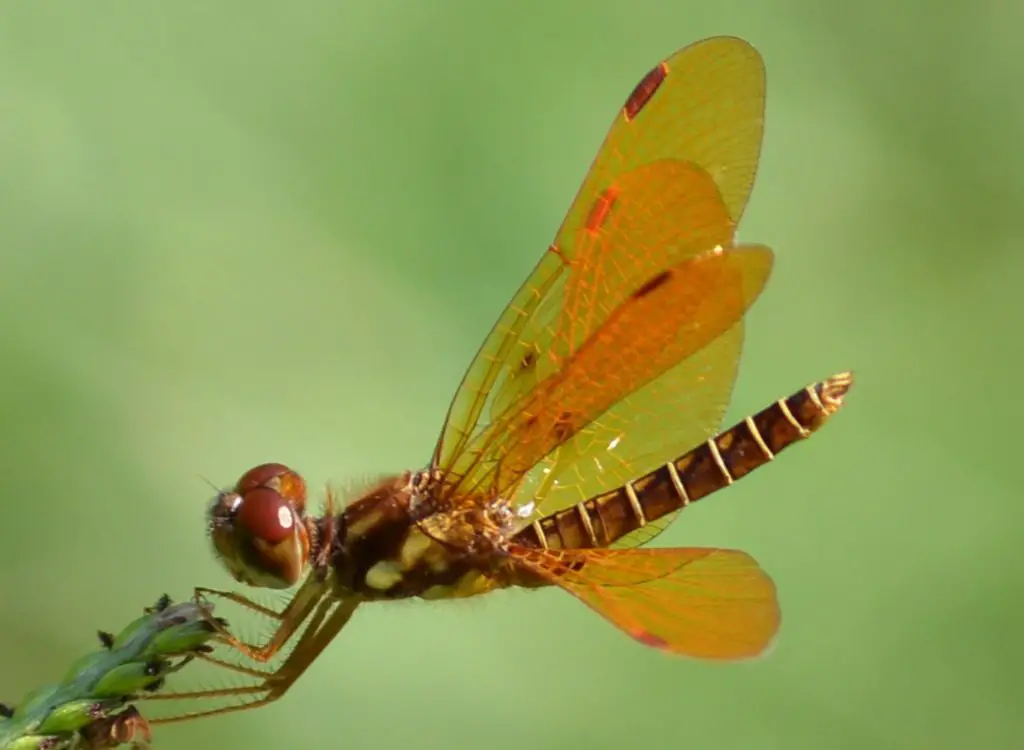
The Eastern Amberwing is a tiny yet vibrant dragonfly that catches the eye with its rich amber-colored wings and metallic golden-orange body. Males in particular display wings that are entirely tinted amber, a feature almost unique among North American dragonflies. Females and immature males resemble wasps with darkly patterned wings and a more muted body coloration, an evolutionary mimicry that helps deter predators such as birds and frogs.
Despite its small size—only about 1 inch (2.5 cm) long with a wingspan of 1.3 to 1.5 inches (3.2 to 3.8 cm)—the Eastern Amberwing is a bold and energetic flier. It often hovers low over shallow water or perches on twigs, plant stems, and even bare rocks close to the water’s edge. Males are extremely territorial and will defend their breeding spots vigorously, darting at intruders with surprising speed. The species also performs unique mating displays, including wing vibrations and hovering.
In Wisconsin, Eastern Amberwings are typically observed from mid-July through early September, especially in the southern half of the state. They prefer small, warm water bodies such as ponds, marshy inlets, and calm streams with ample vegetation. Their preference for sunny habitats and their glowing, amber wings make them especially noticeable on warm summer afternoons when activity peaks.
Autumn Meadowhawk (Sympetrum vicinum)
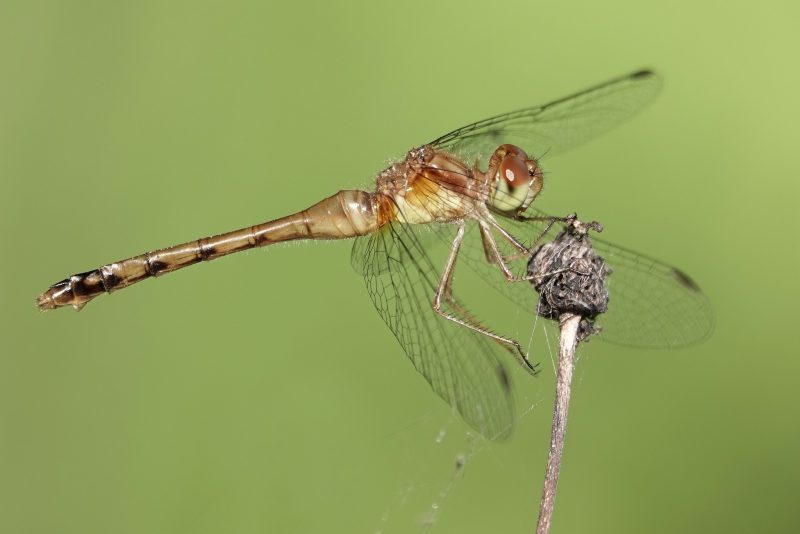
The Autumn Meadowhawk is a slender and graceful dragonfly that becomes more prominent later in the season when most other species begin to fade. Mature males are easily identified by their brilliant red abdomen, while females and immature individuals range from yellow to light brown. One of the most helpful field marks for this species is its pale yellow legs, which stand out compared to the black or dark-colored legs of other meadowhawks.
With a modest body length of about 1.2 to 1.4 inches (3 to 3.5 cm), the Autumn Meadowhawk is among the smaller dragonflies in Wisconsin. It has a calm and approachable demeanor, often seen perching on rocks, shrubs, or even the bare ground in sunlit areas. Unlike many dragonflies that remain near water, this species may travel well into forests, fields, or gardens to hunt for small insects. It is also one of the most cold-tolerant dragonflies, frequently flying well into October or even November during warm spells.
In Wisconsin, the Autumn Meadowhawk is a reliable sign of late summer and fall. It inhabits a range of freshwater environments including bogs, marshes, forest pools, and man-made ponds, though it is also known to stray far from water. Its extended flight season, gentle behavior, and vivid coloration make it a favorite among late-season nature observers and a vital player in controlling insect populations before winter arrives.
Comet Darner (Anax longipes)

The Comet Darner is a strikingly beautiful and rare dragonfly known for its vivid red abdomen and dynamic flight. Males have a bright red abdomen that gives the species its name, contrasted by a green thorax and brilliant green eyes. Females are more subdued in color, typically bearing a brown or reddish-brown body, but they share the same long, slender shape that characterizes the species. Adults reach lengths of about 2.7 to 3.1 inches (7 to 8 cm), with broad, transparent wings that aid in swift and agile flight.
Comet Darners are strong fliers, often seen cruising over ponds and lakes at high speeds. They are not as commonly perched as some other species, preferring to remain airborne for extended periods, which can make them more difficult to observe up close. When they do perch, it is often vertically on vegetation near the water. Males are territorial and patrol specific stretches of water, occasionally engaging in aerial battles with rivals to secure prime mating areas.
In Wisconsin, sightings of the Comet Darner are relatively rare, though they do occur in the southeastern portion of the state, especially during warm, still days in mid to late summer. They prefer fishless, vegetated ponds and shallow marshes, where the larvae (naiads) develop in still water. The species is considered a prized observation for dragonfly enthusiasts due to its uncommon presence and vivid coloration.
Widow Skimmer (Libellula luctuosa)
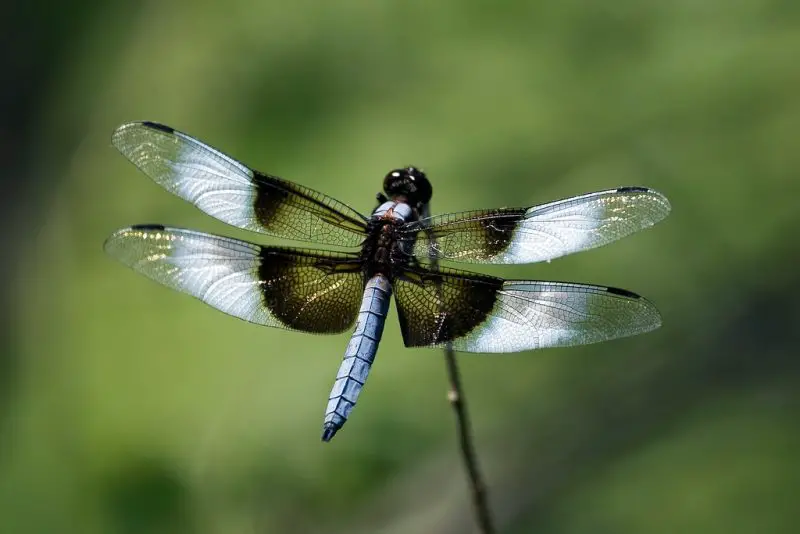
The Widow Skimmer is a handsome dragonfly that displays distinctive wing patterns and a broad, flattened abdomen. Adult males exhibit dark brown basal wing patches bordered by stark white bands, with the remainder of the wings remaining clear. Their abdomen is a powdery blue, while females and immature males are marked with yellow stripes down a dark brown body and possess only the dark wing patches without the white bands. This sexual dimorphism helps observers distinguish between sexes easily.
Typically measuring between 1.7 to 2 inches (4.3 to 5 cm) in length with a wingspan of about 3 inches (7.5 cm), the Widow Skimmer is known for its slow, gliding flight and frequent perching behavior. Males are territorial and commonly perch on stems and sticks near the water’s edge, returning to the same spot after short patrols. Their calm, fluttery flight and preference for resting in open view make them a favorite among photographers and casual nature watchers.
In Wisconsin, Widow Skimmers are widespread and commonly found from June through August. They thrive near ponds, lakes, marshes, and calm river inlets, especially in sunny, open habitats with abundant aquatic vegetation. This species is a frequent sight around suburban and rural water bodies, where it helps regulate insect populations by preying on mosquitoes, midges, and small flies.
Blue Dasher (Pachydiplax longipennis)
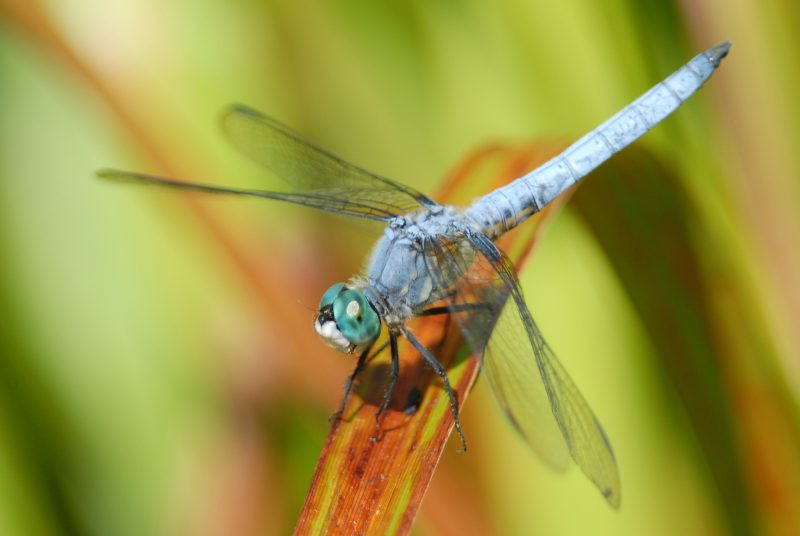
The Blue Dasher is a small but vibrant dragonfly easily identified by its bright blue abdomen and striking facial features. Mature males sport a chalky blue abdomen and a greenish-blue thorax with a metallic sheen, while their large eyes are a brilliant blue-green. Females and immature males display a brown or olive body with yellow side stripes and slightly more muted wings. Their compact size and bold coloring make them one of the most charming species in the region.
Measuring around 1 to 1.5 inches (2.5 to 3.8 cm) in length, Blue Dashers are agile and assertive flyers. Males are known to be especially territorial, often confronting other dragonflies and insects that venture too close to their perch or patrol route. They favor perches such as reeds, plant tips, or rocks and will often return to the same spot after each flight. Their wings are typically held out flat when at rest, and their posture is often described as alert or upright.
In Wisconsin, Blue Dashers are among the most widespread and commonly observed dragonflies, especially from late June through September. They are found near ponds, ditches, marshes, and lake edges, especially where there is some open water and sunlit vegetation. Their adaptability to both natural and man-made aquatic environments ensures that they remain a familiar and welcome presence across much of the state.
Banded Pennant (Celithemis fasciata)
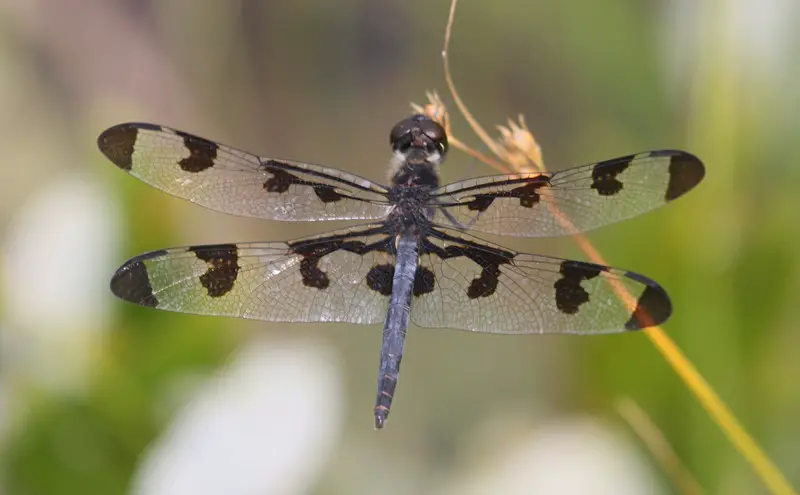
The Banded Pennant is a medium-sized dragonfly known for its striking wing markings and its graceful, gliding flight. Both males and females have translucent wings with dark bands near the base and midsection, giving the species its name. Males feature a bluish body with a slightly frosted appearance and red-tinted eyes, while females tend to be lighter brown or yellowish with similar banded wings. These visual traits make them easy to identify even at a distance.
With a body length of about 1.5 to 1.7 inches (3.8 to 4.3 cm) and a wingspan around 2.5 to 3 inches (6.5 to 7.5 cm), the Banded Pennant has a slender build and an elegant presence. Unlike more aggressive skimmers, Banded Pennants are more passive and spend much of their time gliding above the water or perched on tall grasses and reeds. They are often seen in small groups, and males can sometimes be observed competing subtly for the best perch rather than engaging in fierce territorial battles.
In Wisconsin, Banded Pennants are found primarily in the southern and central regions during the warmer months of summer. They favor shallow ponds, marshes, and grassy lakeshores, especially areas with ample emergent vegetation. Their preference for still or slow-moving water and their gentle behavior make them a favorite among casual observers and a beautiful sign of healthy wetland ecosystems.
American Bluet (Enallagma spp.)

The term American Bluet refers to a group of closely related damselfly species in the genus Enallagma, many of which are extremely similar in appearance. These slender damselflies typically exhibit bright blue and black coloration, especially in males, with females often presenting duller tones such as tan, green, or brown. Their bodies are long and delicate, averaging around 1 to 1.3 inches (2.5 to 3.3 cm) in length, and their wings are narrow and transparent, held together above the body when at rest.
American Bluets are agile flyers but are more often seen perched on grasses or floating vegetation close to the water. They are frequently observed in pairs during the summer breeding season, when males clasp females in a “tandem” mating position. After mating, females often dip their abdomens into the water to lay eggs on submerged vegetation. These damselflies are not aggressive and often coexist peacefully with other species in the same habitat.
In Wisconsin, multiple species of American Bluets are common and widely distributed throughout the state during the warmer months, especially from late spring through early fall. They inhabit a variety of freshwater environments, including lakes, slow-moving streams, marshes, and ponds. Their presence in diverse aquatic habitats makes them useful indicators of good water quality and healthy ecosystems.
American Rubyspot (Hetaerina americana)
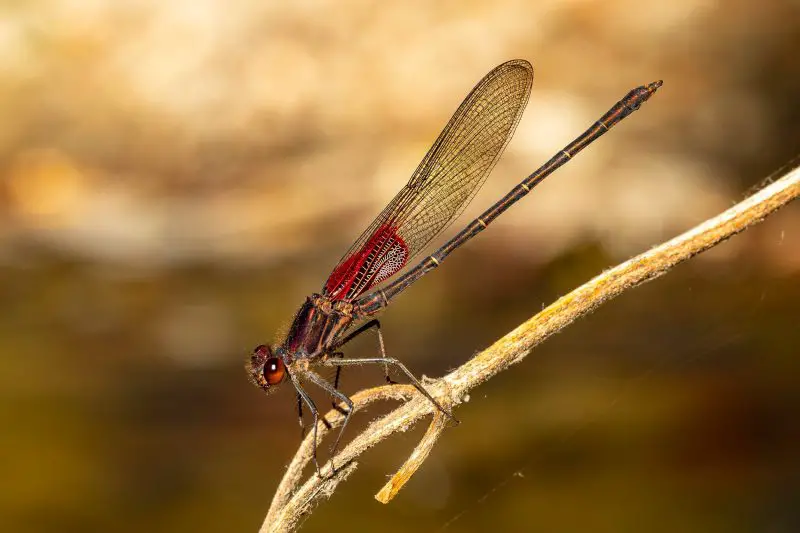
The American Rubyspot is a spectacular damselfly that stands out due to its bold coloration and larger-than-average size. Males are particularly striking with their metallic green bodies and deep red patches at the base of their wings, which flash vibrantly in the sunlight. Females are duller, showing bronze or green tones with smoky, slightly reddish wing bases. Adults typically measure about 1.6 to 1.9 inches (4 to 4.8 cm) in length and possess broad, rounded wings compared to other damselflies.
These damselflies are often seen perched on rocks or vegetation near fast-moving water, especially during bright sunlight when males are most active. Males are territorial and engage in dramatic aerial displays to defend their section of the streambank. Unlike many smaller damselflies, Rubyspots have a somewhat stronger, fluttering flight and can be observed hovering or chasing rivals and potential mates.
In Wisconsin, the American Rubyspot is commonly found along clean, flowing streams and rivers, particularly in the southern and central regions of the state. They are most active from June through September. Their dependence on unpolluted, well-oxygenated waters means their presence is a good sign of ecological health, and they are often monitored by naturalists and citizen scientists for this reason.
Azure Bluet (Enallagma aspersum or E. spp.)
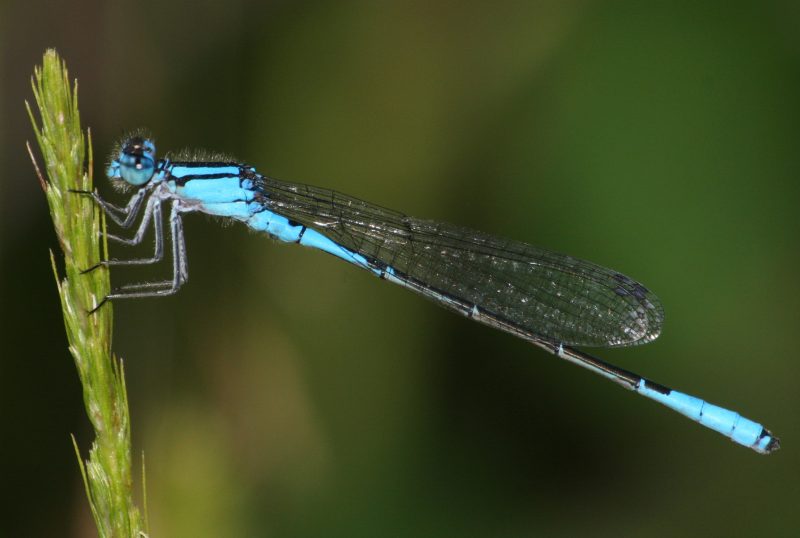
The Azure Bluet is a delicate and brightly colored damselfly, part of the broader Enallagma genus. Males are marked by vivid sky-blue and black patterns along their long, slender abdomens, with a mostly blue thorax and a pair of black shoulder stripes. Females may be blue, green, or tan with subtler markings. These damselflies are relatively small, averaging about 1 to 1.3 inches (2.5 to 3.3 cm) in length, with thin, clear wings held vertically when at rest.
Azure Bluets tend to be less aggressive than some of their cousins and are often seen in calm, still environments. They are strong perchers and frequently rest on low vegetation, floating plants, or debris near water. Mating pairs are commonly observed in tandem or wheel positions during warm months, and egg-laying females are known to partially submerge themselves while depositing eggs—a behavior that can be fascinating to watch.
In Wisconsin, Azure Bluets are widely distributed and can be found near ponds, small lakes, marshes, and slow-moving sections of streams. They prefer sunny areas with abundant aquatic vegetation, especially from late May through August. Although sometimes overlooked due to their small size, their brilliant coloration and graceful movements make them a rewarding find for attentive observers.
Eastern Forktail (Ischnura verticalis)
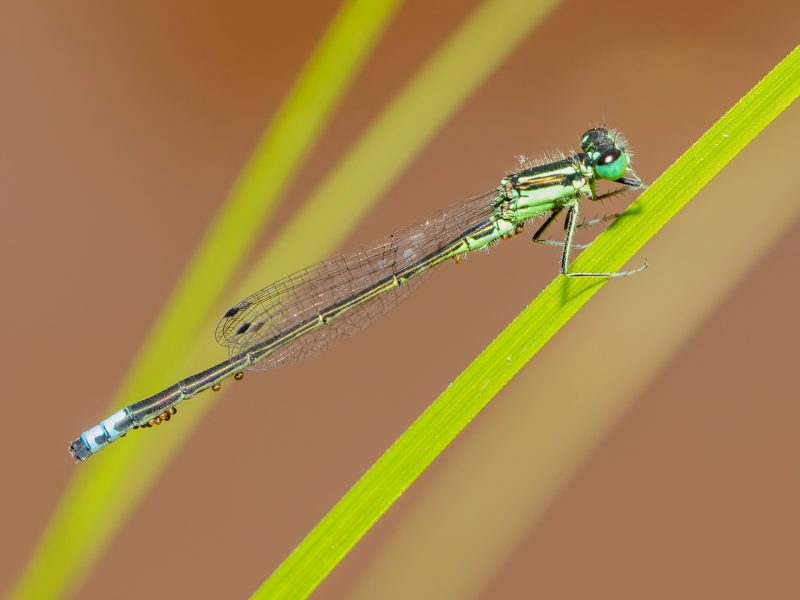
The Eastern Forktail is a tiny, yet unmistakable damselfly species known for its bright green and blue coloration. Males feature a vibrant green thorax with black striping and a mostly black abdomen tipped with bright blue. Females, when immature, are orange with black markings, while mature females transition to a bluish or duller green tone. These damselflies are among the smallest in the region, measuring only about 0.9 to 1.1 inches (2.3 to 2.8 cm) long.
Despite their diminutive size, Eastern Forktails are bold and active hunters. Males can be seen darting low over the water or resting on emergent plants, and they often perch closer to the ground than many other damselflies. This species is also notable for its tolerance of urban and disturbed environments, and it is frequently found in places where other odonates might be absent. Females often oviposit while still attached to the male, a behavior known as tandem oviposition.
In Wisconsin, Eastern Forktails are extremely common and widespread, occurring from May through September across the entire state. They inhabit a broad range of aquatic habitats including ponds, ditches, marshes, and even decorative backyard water gardens. Their adaptability and prolific presence make them one of the most frequently encountered damselflies in the region.
Fragile Forktail (Ischnura posita)
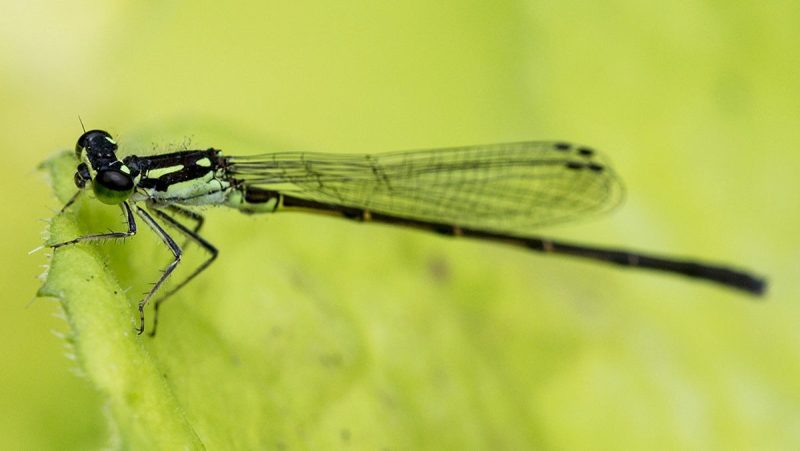
The Fragile Forktail is a small, delicate damselfly known for its slender body and subtle coloration. Adult males typically display a pale blue thorax with black markings, while their abdomen is mostly black with blue segments near the tip. Females often exhibit a variety of color forms, including greenish or brownish tones with black markings, adding to the species’ visual diversity. The wings are narrow and transparent, held together neatly above the body when resting.
This species is named for its fragile appearance and relatively weak flight compared to other damselflies. Fragile Forktails are often seen perching low on vegetation or floating plants near calm, shallow water bodies. They tend to be shy and quick to fly away when disturbed but are frequently encountered in large numbers during the breeding season. Their mating behavior includes the familiar tandem formation common to damselflies, with females laying eggs on submerged stems.
In Wisconsin, Fragile Forktails inhabit marshes, ponds, and slow-moving streams, favoring areas rich in aquatic vegetation. They are most commonly observed from late spring through summer. Due to their preference for still or slow water and lush habitats, their presence can indicate healthy wetland ecosystems in the state.
Blue Fronted Dancer (Argia apicalis)
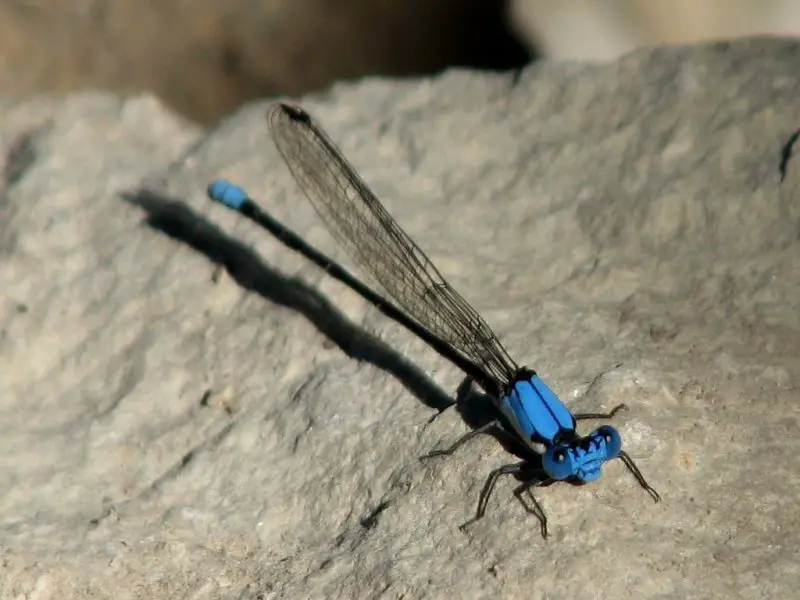
The Blue Fronted Dancer is a medium-sized damselfly with a striking appearance highlighted by its brilliant blue coloration on the thorax and a distinctive black pattern along its abdomen. Males are noted for their powdery blue bodies contrasted with sharp black markings, while females usually have a duller, greenish or brownish coloration but maintain similar body patterns. The species measures about 1.2 to 1.5 inches (3 to 4 cm) long, with clear, narrow wings typical of damselflies.
These damselflies are energetic flyers and often seen darting swiftly along streams and rivers, frequently perching on rocks, stems, or branches near moving water. Males defend territories vigorously, chasing rivals away and attracting females by hovering in preferred spots. Their behavior is lively and visible, making them relatively easy to spot during sunny days when they are most active.
In Wisconsin, Blue Fronted Dancers are primarily found near clear, flowing water bodies such as streams and small rivers, particularly in the southern part of the state. They are most abundant from late spring to early summer. Their preference for clean water environments makes them valuable indicators of stream health in Wisconsin’s aquatic ecosystems.
Familiar Bluet (Enallagma civile)

The Familiar Bluet is one of the most common and widespread damselflies in North America, recognized for its vivid blue and black coloring and small size. Adult males feature a bright blue thorax with black markings and a slender abdomen patterned with blue and black segments. Females can be more variable in color, sometimes greenish or brownish, but typically maintain the same general pattern. Their length ranges from 1 to 1.3 inches (2.5 to 3.3 cm), with clear wings held closed when resting.
Familiar Bluets are agile fliers and are often seen perched on aquatic plants or low vegetation near ponds, lakes, and slow streams. They are tolerant of a range of habitats and frequently encountered in urban and suburban areas. Mating pairs display the classic “wheel” position, and females lay eggs by dipping their abdomens into water, usually while still connected to the male.
In Wisconsin, Familiar Bluets are widespread and abundant from late spring through early fall. They are found throughout the state in diverse freshwater habitats, ranging from large lakes to small, temporary ponds. Their adaptability and high population density make them one of the most frequently observed damselflies by nature enthusiasts in the region.






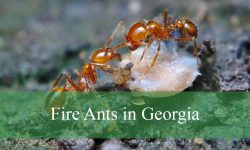
I loved this article. Thank you very much.